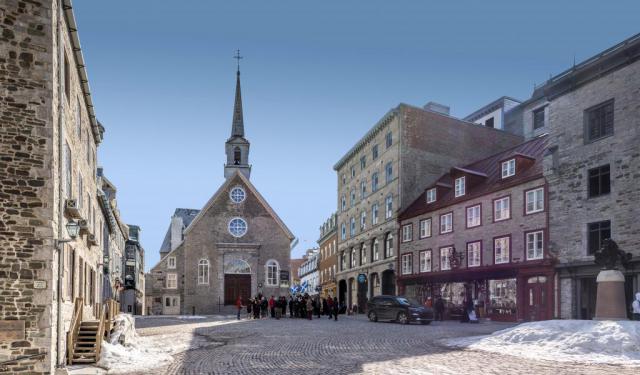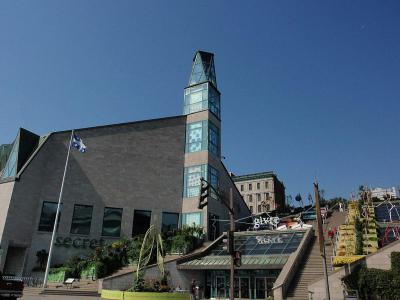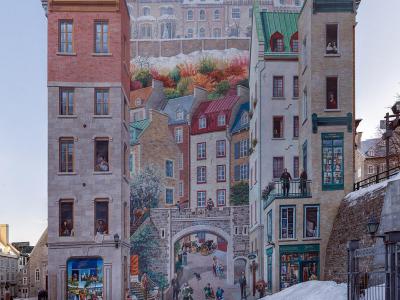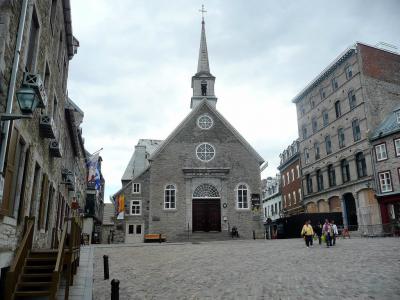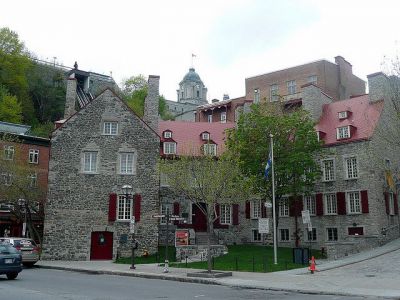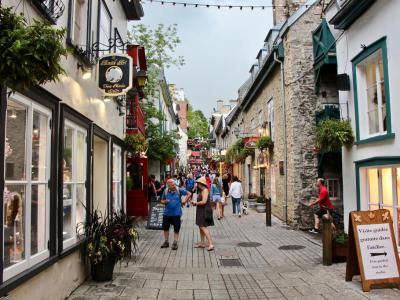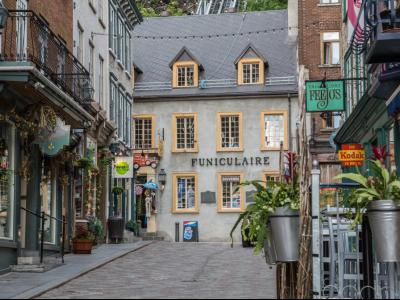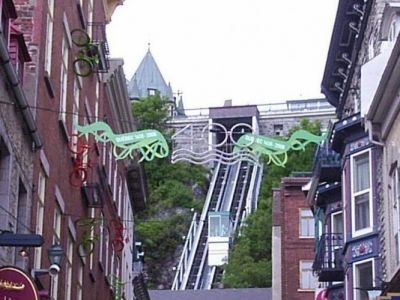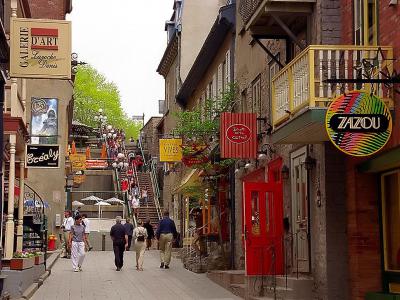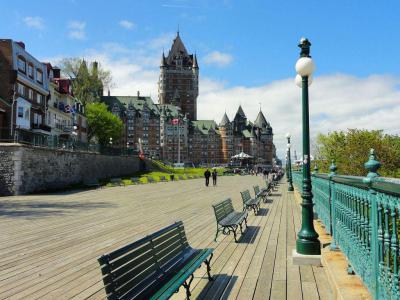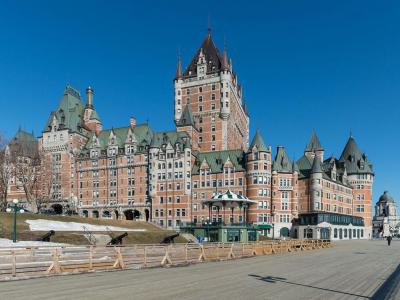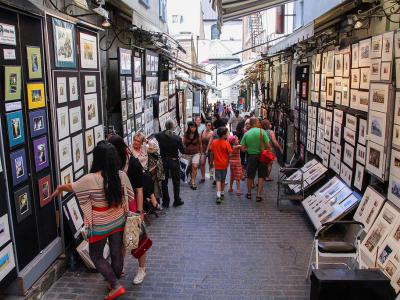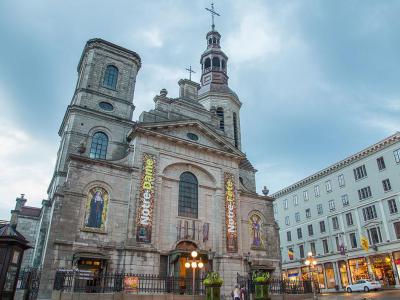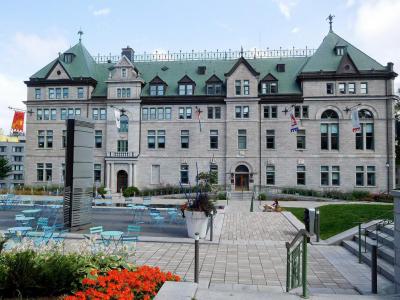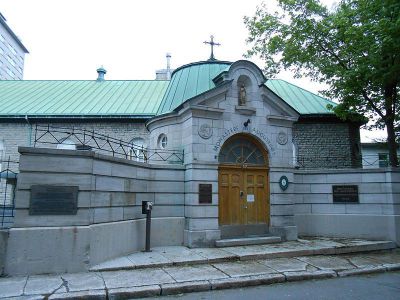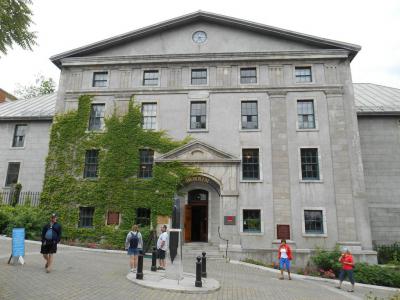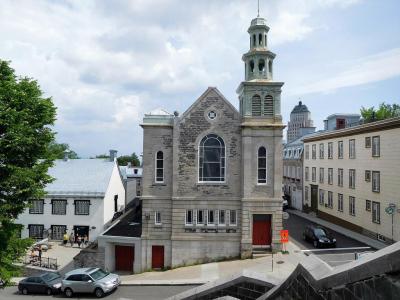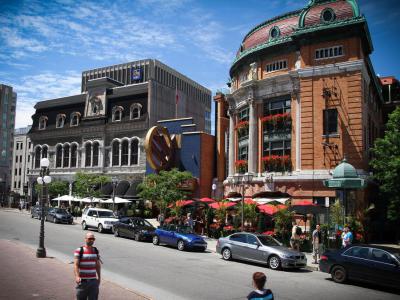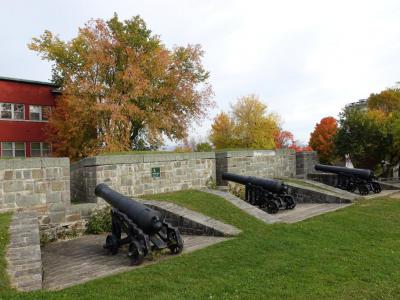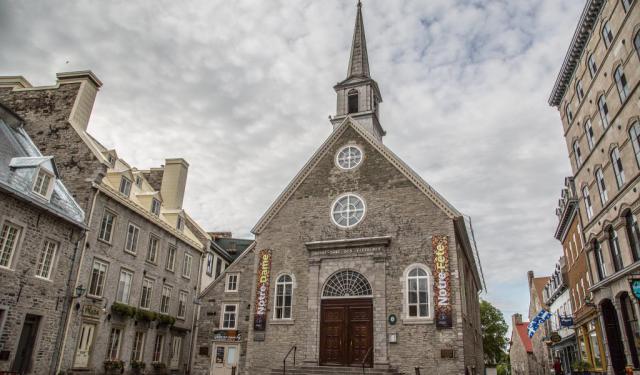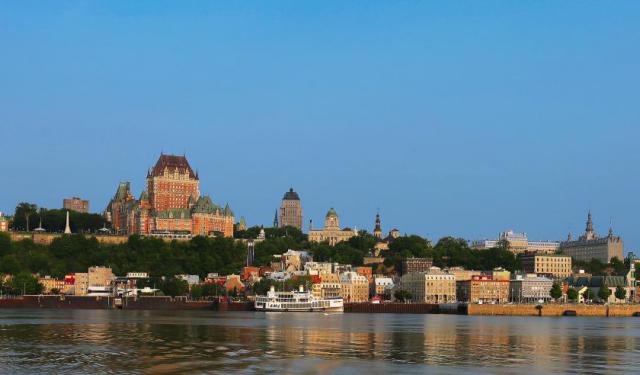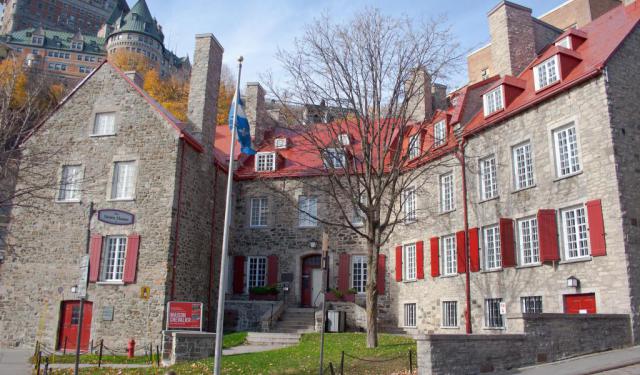Audio Guide: Old Quebec Walk (Self Guided), Quebec City
The historic part of Quebec City known as Old Quebec (French: Vieux-Québec), sometimes also referred to as the Latin Quarter (Quartier Latin), is the neighborhood centered around Cape Diamond (Cap Diamant), located on the eastern edge of Quebec hill promontory. The area comprises Upper Town (Haute-Ville) and Lower Town (Basse-Ville) and is currently listed among UNESCO’s World Heritage Sites.
In 1608, French explorer Samuel de Champlain chose the land of today's Upper Town to set up Fort Saint Louis, the precursor of Quebec City. After the British Conquest, the territory was occupied mainly by British government officials and Catholic clergy, while merchants and artisans, both French and English, settled in the Lower Town. Much of Quebec's traditional architecture – dating from the 17th to the 19th centuries – is concentrated in the old part of the city.
Among the most notable buildings here is the Church of Our Lady of Victories (Notre-Dame-des-Victoires), constructed between 1687 and 1723, as well as some civic buildings like the Quebec City Hall (Hôtel de Ville) and the Museum of the Central Hospital of the Augustinian Convent of Quebec (Musee des Augustines de l'Hôtel-Dieu de Québec).
The ancient stones and winding streets give this area a distinctly European feel. The abundance of shops and restaurants, as well as hotels, such as the imposing historic Frontenac Castle (Château Frontenac), makes the Old City a very popular tourist destination. Also adding to its appeal, albeit modern in terms of architecture, is the Museum of Civilization (Musée de la Civilisation).
The Upper and Lower towns of Old Quebec are connected by numerous staircases, the most notable of which, undoubtedly, is the "Breakneck Stairway". Among other things, this staircase is renowned for the marvelous view opening from its top and the vicinity of the Old Quebec funicular, which links the Upper Town to the historic Petit-Champlain street copiously lined with small boutiques.
If you're in the mood for a bit of Europe organically blended into the Canadian setting, or perhaps would like to have some insight into the New World's history and enjoy great food along the way, you can find all of this and more in the old part of Quebec City. Just embark on our self-guided walking tour and see for yourself!
In 1608, French explorer Samuel de Champlain chose the land of today's Upper Town to set up Fort Saint Louis, the precursor of Quebec City. After the British Conquest, the territory was occupied mainly by British government officials and Catholic clergy, while merchants and artisans, both French and English, settled in the Lower Town. Much of Quebec's traditional architecture – dating from the 17th to the 19th centuries – is concentrated in the old part of the city.
Among the most notable buildings here is the Church of Our Lady of Victories (Notre-Dame-des-Victoires), constructed between 1687 and 1723, as well as some civic buildings like the Quebec City Hall (Hôtel de Ville) and the Museum of the Central Hospital of the Augustinian Convent of Quebec (Musee des Augustines de l'Hôtel-Dieu de Québec).
The ancient stones and winding streets give this area a distinctly European feel. The abundance of shops and restaurants, as well as hotels, such as the imposing historic Frontenac Castle (Château Frontenac), makes the Old City a very popular tourist destination. Also adding to its appeal, albeit modern in terms of architecture, is the Museum of Civilization (Musée de la Civilisation).
The Upper and Lower towns of Old Quebec are connected by numerous staircases, the most notable of which, undoubtedly, is the "Breakneck Stairway". Among other things, this staircase is renowned for the marvelous view opening from its top and the vicinity of the Old Quebec funicular, which links the Upper Town to the historic Petit-Champlain street copiously lined with small boutiques.
If you're in the mood for a bit of Europe organically blended into the Canadian setting, or perhaps would like to have some insight into the New World's history and enjoy great food along the way, you can find all of this and more in the old part of Quebec City. Just embark on our self-guided walking tour and see for yourself!
How it works: Download the app "GPSmyCity: Walks in 1K+ Cities" from Apple App Store or Google Play Store to your mobile phone or tablet. The app turns your mobile device into a personal tour guide and its built-in GPS navigation functions guide you from one tour stop to next. The app works offline, so no data plan is needed when traveling abroad.
Old Quebec Walk Map
Guide Name: Old Quebec Walk
Guide Location: Canada » Quebec City (See other walking tours in Quebec City)
Guide Type: Self-guided Walking Tour (Sightseeing)
# of Attractions: 18
Tour Duration: 2 Hour(s)
Travel Distance: 2.6 Km or 1.6 Miles
Author: susan
Sight(s) Featured in This Guide:
Guide Location: Canada » Quebec City (See other walking tours in Quebec City)
Guide Type: Self-guided Walking Tour (Sightseeing)
# of Attractions: 18
Tour Duration: 2 Hour(s)
Travel Distance: 2.6 Km or 1.6 Miles
Author: susan
Sight(s) Featured in This Guide:
- Museum of Civilization (Musee de la Civilisation)
- Quebec City Mural (La Fresque des Quebecois)
- Notre-Dame-des-Victoires (Our Lady of Victories Church)
- Chevalier House (Maison Chevalier)
- Petit-Champlain Street (Rue du Petit-Champlain)
- Louis Jolliet House (Maison Louis Jolliet)
- Old Quebec Funicular (Funiculaire du Vieux-Quebec)
- Breakneck Steps (L'Escalier Casse-Cou)
- Dufferin Terrace (Terrasse Dufferin)
- Chateau Frontenac
- Rue du Trésor
- Notre-Dame de Québec
- City Hall of Quebec City (Hotel de Ville)
- Museum of the Central Hospital of the Augustinian Convent of Quebec (Musee des Augustines de l'Hôtel
- Morrin Centre
- Jesuit Chapel (Chapelle des Jesuites)
- D’Youville Square (Place d'Youville)
- Artillery Park Heritage Site
1) Museum of Civilization (Musee de la Civilisation) (must see)
The Museum of Civilization is found in the heart of Quebec City's port district, not far from the shores of the Saint Lawrence River. Inaugurated in 1988, the museum explores the history (much as the present and the future) of human civilization and that of Quebec, in particular.
Architecturally, the venue comprises several historic buildings, such as the former Bank of Quebec edifice, the Guillaume-Estèbe house (Maison Guillaume-Estèbe) – now home to the museum shop and administration, and the vaulted cellars of the Pagé-Quercy house. Albeit generally in line with the traditional style of this part of the city, the museum's main building's modern exterior – the roof, the windows, and the bell tower – strikingly contrasts the neighboring architecture.
Designed by Moshe Safdie, the mastermind behind Montreal's revolutionary Habitat 67, the museum's front entry is tucked away into an incline, which gives it a bit of a natural touch, with a glass roof and greenery sprouting along the sides. Once inside, you will find yourself in a well-lit spacious lobby, clad in glass and dominated by Astri Reusch's "La Débâcle" sculpture. This environmental piece is said to be inspired by the springtime accumulation of ice in the Saint Lawrence river.
The three-story building accommodates ten different exhibits simultaneously, three of which are permanent and rooted in the region's history. The one called “The Time of Quebecers” (“Le Temps des Québécois”) is a summary of significant events that have shaped modern Quebec, from the days of the first nations and Inuit culture to the present.
Located in the basement are the so-called “discovery spaces”, interactive activity sites intended mainly for the young audience. Here, the exhibit called “Once upon a time” allows children to dress up as their favorite characters and recreate tales in an interactive environment, while the on-site Creaform lab introduces visitors to the issues of the digital world such as robotics, basic programming, and electrical circuits.
Vast on the inside, the museum is capable of holding hundreds of people at a time, so you'll never feel cramped. There's something for everyone, regardless of age and specific interests. Many exhibits offer "hands-on" experience. Although both English and French tours are available, visitors are free to walk through and explore on their own.
Tip:
If you arrive at 4 pm for the last hour, you can get in at a half price, but note: to see the core exhibits, you should allow yourself at least three hours. Alternatively, you can get a discount if you visit this museum and the National Museum of Fine Arts (Musée National des Beaux-Arts) on the same day.
Architecturally, the venue comprises several historic buildings, such as the former Bank of Quebec edifice, the Guillaume-Estèbe house (Maison Guillaume-Estèbe) – now home to the museum shop and administration, and the vaulted cellars of the Pagé-Quercy house. Albeit generally in line with the traditional style of this part of the city, the museum's main building's modern exterior – the roof, the windows, and the bell tower – strikingly contrasts the neighboring architecture.
Designed by Moshe Safdie, the mastermind behind Montreal's revolutionary Habitat 67, the museum's front entry is tucked away into an incline, which gives it a bit of a natural touch, with a glass roof and greenery sprouting along the sides. Once inside, you will find yourself in a well-lit spacious lobby, clad in glass and dominated by Astri Reusch's "La Débâcle" sculpture. This environmental piece is said to be inspired by the springtime accumulation of ice in the Saint Lawrence river.
The three-story building accommodates ten different exhibits simultaneously, three of which are permanent and rooted in the region's history. The one called “The Time of Quebecers” (“Le Temps des Québécois”) is a summary of significant events that have shaped modern Quebec, from the days of the first nations and Inuit culture to the present.
Located in the basement are the so-called “discovery spaces”, interactive activity sites intended mainly for the young audience. Here, the exhibit called “Once upon a time” allows children to dress up as their favorite characters and recreate tales in an interactive environment, while the on-site Creaform lab introduces visitors to the issues of the digital world such as robotics, basic programming, and electrical circuits.
Vast on the inside, the museum is capable of holding hundreds of people at a time, so you'll never feel cramped. There's something for everyone, regardless of age and specific interests. Many exhibits offer "hands-on" experience. Although both English and French tours are available, visitors are free to walk through and explore on their own.
Tip:
If you arrive at 4 pm for the last hour, you can get in at a half price, but note: to see the core exhibits, you should allow yourself at least three hours. Alternatively, you can get a discount if you visit this museum and the National Museum of Fine Arts (Musée National des Beaux-Arts) on the same day.
2) Quebec City Mural (La Fresque des Quebecois)
Standing at almost three stories tall and spanning an impressive 4,520 square feet (or 420 square meters), the Quebec City Mural holds the distinction of being the largest and most historically significant trompe l'oeil artwork in the historic Old Quebec area. It's nestled in the iconic Petit Champlain district.
Unveiled to the public in 1999, this monumental mural vividly narrates the rich history of Quebec City, spanning over 400 years, and showcases key historical figures integral to its story. The creation of this colossal masterpiece required the collaborative effort of twelve artists hailing from France and Canada. Their work was closely overseen by experts, including historians, geographers, and others well-versed in the city's heritage.
The mural's location at the intersection of Notre Dame street was strategically chosen, ensuring that no adjacent structures obstruct the view of the artwork. This means that anyone with the inclination can spend hours meticulously examining its intricate details.
The expansive fresco showcases 16 prominent figures from Quebec's history, featuring renowned personalities such as Jacques Cartier, Samuel de Champlain, and Lord Dufferin. It also pays homage to cultural icons like singer-songwriter Félix Leclerc and politician Louis-Joseph Papineau.
Additionally, the mural portrays famous local buildings with notable individuals seemingly peering out from the windows. It includes architectural landmarks like the Breakneck Stairway (L'Escalier Casse-Cou) and the Frontenac Castle (Château Frontenac). Furthermore, it incorporates representations of the distinct climatic seasons experienced in Quebec.
Given its close proximity to a bookstore, the mural also honors numerous authors and artists of Quebecois origin. Notably, the popularity of this mural sparked a trend of trompe l'oeil artwork throughout the city, resulting in many buildings adorned with similarly historically meaningful murals over the years.
Unveiled to the public in 1999, this monumental mural vividly narrates the rich history of Quebec City, spanning over 400 years, and showcases key historical figures integral to its story. The creation of this colossal masterpiece required the collaborative effort of twelve artists hailing from France and Canada. Their work was closely overseen by experts, including historians, geographers, and others well-versed in the city's heritage.
The mural's location at the intersection of Notre Dame street was strategically chosen, ensuring that no adjacent structures obstruct the view of the artwork. This means that anyone with the inclination can spend hours meticulously examining its intricate details.
The expansive fresco showcases 16 prominent figures from Quebec's history, featuring renowned personalities such as Jacques Cartier, Samuel de Champlain, and Lord Dufferin. It also pays homage to cultural icons like singer-songwriter Félix Leclerc and politician Louis-Joseph Papineau.
Additionally, the mural portrays famous local buildings with notable individuals seemingly peering out from the windows. It includes architectural landmarks like the Breakneck Stairway (L'Escalier Casse-Cou) and the Frontenac Castle (Château Frontenac). Furthermore, it incorporates representations of the distinct climatic seasons experienced in Quebec.
Given its close proximity to a bookstore, the mural also honors numerous authors and artists of Quebecois origin. Notably, the popularity of this mural sparked a trend of trompe l'oeil artwork throughout the city, resulting in many buildings adorned with similarly historically meaningful murals over the years.
3) Notre-Dame-des-Victoires (Our Lady of Victories Church)
While exploring Quebec City's Lower Town (Basse-Ville), you'll discover the charming Catholic basilica, Our Lady of Victories (Notre-Dame-des-Victoires), on Royal Square (Place Royale). This basilica boasts Neoclassical design and a distinctive spire-topped steeple. It holds the distinction of being the oldest stone church in Canada and one of the oldest in North America. The church, constructed between 1687 and 1723, stands on the site of Samuel de Champlain's former residence, the city's founder.
Originally dedicated to the baby Jesus (l'Enfant Jésus), the church was renamed Our Lady of Victory after the Battle of Quebec in 1690. In 1711, it changed its name to "of Victories" following the sinking of British Admiral Hovenden Walker's fleet due to bad weather. Despite suffering damage during the British bombardment before the Battle of the Plains of Abraham in September 1759, the church was fully restored in 1816.
Today, it holds the status of a historic monument and continues to attract tourists while serving as a place of worship. Recent restoration efforts have returned the church to its original French colonial style. Despite various renovations spanning centuries, some original elements from the 1600s, such as a basement wall fragment and the turret on the facade, still remain.
The austere church interior features 17th to 19th-century paintings by artists like Van Dyck, Rubens, and Boyermans, as well as unique frescoes depicting local history by artist Jean-Marie Tardivel. Most captivating is a suspended replica of the 17th-century vessel Le Brézé, used to transport French soldiers to New France in 1664 under Marquis de Tracy. It was salvaged from church ruins in 1759.
In 2002, the church gained recognition as a filming location for the movie "Catch Me If You Can," featuring Leonardo DiCaprio and Tom Hanks.
Originally dedicated to the baby Jesus (l'Enfant Jésus), the church was renamed Our Lady of Victory after the Battle of Quebec in 1690. In 1711, it changed its name to "of Victories" following the sinking of British Admiral Hovenden Walker's fleet due to bad weather. Despite suffering damage during the British bombardment before the Battle of the Plains of Abraham in September 1759, the church was fully restored in 1816.
Today, it holds the status of a historic monument and continues to attract tourists while serving as a place of worship. Recent restoration efforts have returned the church to its original French colonial style. Despite various renovations spanning centuries, some original elements from the 1600s, such as a basement wall fragment and the turret on the facade, still remain.
The austere church interior features 17th to 19th-century paintings by artists like Van Dyck, Rubens, and Boyermans, as well as unique frescoes depicting local history by artist Jean-Marie Tardivel. Most captivating is a suspended replica of the 17th-century vessel Le Brézé, used to transport French soldiers to New France in 1664 under Marquis de Tracy. It was salvaged from church ruins in 1759.
In 2002, the church gained recognition as a filming location for the movie "Catch Me If You Can," featuring Leonardo DiCaprio and Tom Hanks.
4) Chevalier House (Maison Chevalier)
The Chevalier House (Maison Historique Chevalier) is a prominent example of French urban architecture in New France. This historical structure is composed of three distinct buildings from different time periods.
In the center stands the former residence of shipowner Jean-Baptiste Chevalier, constructed in 1752, which is closely connected to the neighboring mansard-style Frérot House, dating back to either 1683 or 1695. Additionally, the Chesnay House, dating back to 1660 or 1675, completes the trio.
All three houses suffered destruction by fire but were subsequently rebuilt in 1762. Following the British conquest of the region, the entire complex underwent partial renovations and was repurposed for commercial use. Starting in 1807, the property was leased to an innkeeper who named it the London Coffee House, a name that persisted until the early 20th century.
In the 1950s, these buildings narrowly avoided demolition when the government of Quebec acquired them as part of a significant restoration effort in the Royal Square area. Subsequently, in 1965, the complex received recognition as a historic monument and was transformed into a museum.
Set against the backdrop of Frontenac Castle, the Chevalier House offers an excellent photo opportunity for architecture enthusiasts, reflecting a substantial portion of the area's historical legacy. During the Quebec Carnival in February, it frequently hosts traditional music events.
In the center stands the former residence of shipowner Jean-Baptiste Chevalier, constructed in 1752, which is closely connected to the neighboring mansard-style Frérot House, dating back to either 1683 or 1695. Additionally, the Chesnay House, dating back to 1660 or 1675, completes the trio.
All three houses suffered destruction by fire but were subsequently rebuilt in 1762. Following the British conquest of the region, the entire complex underwent partial renovations and was repurposed for commercial use. Starting in 1807, the property was leased to an innkeeper who named it the London Coffee House, a name that persisted until the early 20th century.
In the 1950s, these buildings narrowly avoided demolition when the government of Quebec acquired them as part of a significant restoration effort in the Royal Square area. Subsequently, in 1965, the complex received recognition as a historic monument and was transformed into a museum.
Set against the backdrop of Frontenac Castle, the Chevalier House offers an excellent photo opportunity for architecture enthusiasts, reflecting a substantial portion of the area's historical legacy. During the Quebec Carnival in February, it frequently hosts traditional music events.
5) Petit-Champlain Street (Rue du Petit-Champlain) (must see)
A charming narrow street at the base of Cape Diamond, known as Rue du Petit-Champlain, serves as the heart of the quaint neighborhood sharing its name. This area pays homage to Samuel de Champlain, the French explorer credited with founding Quebec City back in 1608.
Stretching a mere 814 feet (or 260 meters) in length, Petit-Champlain, translating to "Little Champlain," should not be confused with Champlain Street further to the west, located in the Cap-Blanc district. These two streets were once connected until a rockslide in 1889 separated them.
Towards the southern terminus of Petit-Champlain, you'll come across a sizable trompe-l'œil mural adorning the side of a three-story building at No. 102. This mural vividly recounts the neighborhood's history, encompassing significant events such as the 1759 bombardments, landslides, and numerous fires that have plagued the area over the years.
At the opposite end of the street lies the renowned Breakneck Staircase, aptly named for its steepness, offering a picturesque view of the surrounding area.
Just beyond the staircase awaits the lower entrance to the Old Quebec Funicular, known as the Funiculaire du Vieux-Québec. Operating since 1879, this electric cableway navigates Cape Diamond at a sharp 45-degree angle, covering a total distance of 64 meters (210 feet).
In 2014, Petit-Champlain received recognition as "the most remarkable street" in Canada, a title bestowed upon it through public and professional polls conducted during an event organized by the Canadian Institute of Planners.
Stretching a mere 814 feet (or 260 meters) in length, Petit-Champlain, translating to "Little Champlain," should not be confused with Champlain Street further to the west, located in the Cap-Blanc district. These two streets were once connected until a rockslide in 1889 separated them.
Towards the southern terminus of Petit-Champlain, you'll come across a sizable trompe-l'œil mural adorning the side of a three-story building at No. 102. This mural vividly recounts the neighborhood's history, encompassing significant events such as the 1759 bombardments, landslides, and numerous fires that have plagued the area over the years.
At the opposite end of the street lies the renowned Breakneck Staircase, aptly named for its steepness, offering a picturesque view of the surrounding area.
Just beyond the staircase awaits the lower entrance to the Old Quebec Funicular, known as the Funiculaire du Vieux-Québec. Operating since 1879, this electric cableway navigates Cape Diamond at a sharp 45-degree angle, covering a total distance of 64 meters (210 feet).
In 2014, Petit-Champlain received recognition as "the most remarkable street" in Canada, a title bestowed upon it through public and professional polls conducted during an event organized by the Canadian Institute of Planners.
6) Louis Jolliet House (Maison Louis Jolliet)
The historic Louis Jolliet House, at 16 Petit-Champlain Street, today serves as the main entrance to the Old Quebec funicular. Designed by architect Claude Baillif, this was one of the earliest residences in Old Quebec built a year after the great fire of 1682.
The fire, which had almost completely razed the Lower Town, eventually prompted the authorities to require that all buildings be made of stone and fitted with firewalls. Among other things, this decision resulted in the spread of the first suburbs outside the city walls since poorer settlers could not meet the new costly requirements and were thus forced to move out.
The owner of the house, Louis Jolliet, an explorer, cartographer and hydrographer, lived here until his death in 1700. He was the first Quebec-born Canadian to make history. During one of his expeditions, Jolliet discovered and mapped the Mississippi River, being the first person of European parentage to accomplish such a feat.
Heavily damaged during the British Conquest and by a number of fires that happened later on, the house underwent several transformations that have reduced its state of authenticity. Nonetheless, some of its original features, attributing to the urban architecture of the French Colonial period, have survived.
The commanding location – at the top of Sous-le-Fort street – gives this property a privileged place in the urban landscape and, together with the access to the funicular, adds more value to it in the eyes of multiple visitors. As of 1985, the building has been an integral part of the Old Quebec UNESCO World Heritage Site.
The fire, which had almost completely razed the Lower Town, eventually prompted the authorities to require that all buildings be made of stone and fitted with firewalls. Among other things, this decision resulted in the spread of the first suburbs outside the city walls since poorer settlers could not meet the new costly requirements and were thus forced to move out.
The owner of the house, Louis Jolliet, an explorer, cartographer and hydrographer, lived here until his death in 1700. He was the first Quebec-born Canadian to make history. During one of his expeditions, Jolliet discovered and mapped the Mississippi River, being the first person of European parentage to accomplish such a feat.
Heavily damaged during the British Conquest and by a number of fires that happened later on, the house underwent several transformations that have reduced its state of authenticity. Nonetheless, some of its original features, attributing to the urban architecture of the French Colonial period, have survived.
The commanding location – at the top of Sous-le-Fort street – gives this property a privileged place in the urban landscape and, together with the access to the funicular, adds more value to it in the eyes of multiple visitors. As of 1985, the building has been an integral part of the Old Quebec UNESCO World Heritage Site.
7) Old Quebec Funicular (Funiculaire du Vieux-Quebec) (must see)
The Old Quebec Funicular, known as the Funiculaire du Vieux-Québec, is a cable railway that connects the Upper and Lower Towns of Old Quebec. It runs between Dufferin Terrace and Petit-Champlain Street.
Besides its speed and convenience, this mode of transportation holds historical significance. The funicular was originally established in 1879. Initially, it operated using a hydraulic system that required the transfer of water between reservoirs before it could function. However, in 1907, it underwent a conversion to electricity.
In 1945, a significant fire damaged the structure, necessitating its reconstruction, which was completed within a year. Subsequent renovations in 1978 and 1998 made both cabins fully autonomous, essentially operating as elevators. From a technical standpoint, it's now more of an inclined lift than a traditional funicular.
Despite its small size, the funicular provides a remarkable way to enjoy the scenery. When traveling uphill, you enter through the Louis Jolliet House and, after obtaining your ticket (which usually takes about 10 minutes on a summer afternoon), ascend 64 meters (210 feet) at a 45-degree angle. During the ride, you can take in stunning views of the Lower Town, the Saint Lawrence River, and the iconic Frontenac Castle (Château Frontenac).
Being here offers a one-of-a-kind experience that you're unlikely to find in many other places around the world. Although the ride itself is short, the enjoyment it provides is long-lasting!
For added enjoyment, there is an on-site gift shop and café.
Besides its speed and convenience, this mode of transportation holds historical significance. The funicular was originally established in 1879. Initially, it operated using a hydraulic system that required the transfer of water between reservoirs before it could function. However, in 1907, it underwent a conversion to electricity.
In 1945, a significant fire damaged the structure, necessitating its reconstruction, which was completed within a year. Subsequent renovations in 1978 and 1998 made both cabins fully autonomous, essentially operating as elevators. From a technical standpoint, it's now more of an inclined lift than a traditional funicular.
Despite its small size, the funicular provides a remarkable way to enjoy the scenery. When traveling uphill, you enter through the Louis Jolliet House and, after obtaining your ticket (which usually takes about 10 minutes on a summer afternoon), ascend 64 meters (210 feet) at a 45-degree angle. During the ride, you can take in stunning views of the Lower Town, the Saint Lawrence River, and the iconic Frontenac Castle (Château Frontenac).
Being here offers a one-of-a-kind experience that you're unlikely to find in many other places around the world. Although the ride itself is short, the enjoyment it provides is long-lasting!
For added enjoyment, there is an on-site gift shop and café.
8) Breakneck Steps (L'Escalier Casse-Cou) (must see)
Built in 1635, the legendary Breakneck Stairs or Steps (Escalier Casse-Cou) is the oldest stairway in Quebec City. Named so for its steepness, the staircase was previously known as Champlain Stairs (escalier Champlain), Beggars' Stairs (escalier du Quêteux), and Lower Town Stairs (escalier de la Basse-Ville).
The first steps and landings were made of wood and were much narrower and steeper than today. In 1889, the staircase was replaced with a larger iron one, expanded from a single to three parallel flights, designed by the celebrated local architect and engineer, Charles Baillargé. The stairs that we see now, however, resulted from the major overhaul in the late 1960s.
While not Quebec City's longest staircase (59 steps only), the Breakneck Stairs is probably the city's most useful as it provides a shortcut between Côte de la Montagne street in the Upper Town to the corner of Petit-Champlain and Sous-le-Fort streets in the Lower Town. Despite the ominous name, coined by British tour guides in the mid-19th century (and made official in the 1960s), no serious injuries have ever been reported on the stairs.
The upper level, near Côte de la Montagne, hosts a few artisan kiosks. Tourists adore this location for the wonderful view it affords. As you gaze down upon Petit-Champlain – one of Canada's most picturesque streets, stretching along the foot of the cliff – you may think you are looking at a postcard come to life.
In the winter, the scene is even more sublime with the Christmas lights twinkling and snow gently falling. In the summer, the ultimate experience on the Stairs consists of eating or having a drink at one of the restaurant terraces located on different landings. And when it comes to taking pictures, any time of the year is good, on any of the landings, for a personalized postcard made.
At the bottom of the Stairs, you will find several boutiques, including the famed confectionery La Fudgerie, plus a number restaurants and other delights.
The first steps and landings were made of wood and were much narrower and steeper than today. In 1889, the staircase was replaced with a larger iron one, expanded from a single to three parallel flights, designed by the celebrated local architect and engineer, Charles Baillargé. The stairs that we see now, however, resulted from the major overhaul in the late 1960s.
While not Quebec City's longest staircase (59 steps only), the Breakneck Stairs is probably the city's most useful as it provides a shortcut between Côte de la Montagne street in the Upper Town to the corner of Petit-Champlain and Sous-le-Fort streets in the Lower Town. Despite the ominous name, coined by British tour guides in the mid-19th century (and made official in the 1960s), no serious injuries have ever been reported on the stairs.
The upper level, near Côte de la Montagne, hosts a few artisan kiosks. Tourists adore this location for the wonderful view it affords. As you gaze down upon Petit-Champlain – one of Canada's most picturesque streets, stretching along the foot of the cliff – you may think you are looking at a postcard come to life.
In the winter, the scene is even more sublime with the Christmas lights twinkling and snow gently falling. In the summer, the ultimate experience on the Stairs consists of eating or having a drink at one of the restaurant terraces located on different landings. And when it comes to taking pictures, any time of the year is good, on any of the landings, for a personalized postcard made.
At the bottom of the Stairs, you will find several boutiques, including the famed confectionery La Fudgerie, plus a number restaurants and other delights.
9) Dufferin Terrace (Terrasse Dufferin) (must see)
The Dufferin Terrace (Terrasse Dufferin) is a wide, wooden boardwalk wrapping around the front of the Frontenac Castle (Château Frontenac) towards the Citadel of Quebec. The abundance of gazebos and benches here, not to mention the panoramic views of the Saint Lawrence River, the South Shore, and Orleans Island (Île d'Orléans), makes this place an equally loved leisure spot by both locals and tourists.
Remarkably, the use of wooden planks gives this whole thing an “air of summer”, even in the middle of winter when the famous Terrasse Dufferin Slides, a huge (150-metre/490-foot) toboggan on the south end of the terrace, is open during the Quebec Winter Carnival (Carnaval de Québec), from late January to mid-February.
The promenade was built in 1838 and was first known as Durham Terrace. It was enlarged in 1854 and then remodeled, in 1878-1879, under the direction of the then Governor General of Canada, Marquess of Dufferin, whose name it now bears. Each of the six gazebos found on this boardwalk has a name – going north-south, it is Frontenac, Lorne, Princess Louise, Victoria, Dufferin, and Plessis.
Underneath the terrace is the archaeological site of Saint Louis Fort and Castle (Château Saint-Louis), featuring the remains of the former seat of power occupied by the French and British governors of the territory from 1620 to 1834 (when it was destroyed by fire) – it is now open for viewing through the three specially built-in peek-a-boo windows.
Also, at the southern end of the terrace is the entry to the Governors' Promenade, a walkway to the Plains of Abraham built into the cliffs below the Citadel. Nearby, a few old guns recall the strategic position of the place once guarded by artillery batteries.
Remarkably, the use of wooden planks gives this whole thing an “air of summer”, even in the middle of winter when the famous Terrasse Dufferin Slides, a huge (150-metre/490-foot) toboggan on the south end of the terrace, is open during the Quebec Winter Carnival (Carnaval de Québec), from late January to mid-February.
The promenade was built in 1838 and was first known as Durham Terrace. It was enlarged in 1854 and then remodeled, in 1878-1879, under the direction of the then Governor General of Canada, Marquess of Dufferin, whose name it now bears. Each of the six gazebos found on this boardwalk has a name – going north-south, it is Frontenac, Lorne, Princess Louise, Victoria, Dufferin, and Plessis.
Underneath the terrace is the archaeological site of Saint Louis Fort and Castle (Château Saint-Louis), featuring the remains of the former seat of power occupied by the French and British governors of the territory from 1620 to 1834 (when it was destroyed by fire) – it is now open for viewing through the three specially built-in peek-a-boo windows.
Also, at the southern end of the terrace is the entry to the Governors' Promenade, a walkway to the Plains of Abraham built into the cliffs below the Citadel. Nearby, a few old guns recall the strategic position of the place once guarded by artillery batteries.
10) Chateau Frontenac
One of the most astonishing buildings in Quebec, renowned for its fortress-like architecture and majestic location – sitting on top of the Cape Diamond (Cap Diamant) ridge, the Frontenac Castle (Château Frontenac) proudly holds the title of the "most photographed hotel in the world".
Opened in 1893, this was one of the first grand railway hotels built by the Canadian Pacific Railway in the country, whose 18-floor grandness, augmented by the 54-meter (177-foot) elevation that it sits at, rivaled any European hotel of the day and grabbed the attention of travelers visiting the city.
The Châteauesque style of the building was later replicated in other grand railway hotels erected throughout Canada from the late 19th to the early 20th centuries. American architect Bruce Price drew inspiration from Medieval, Renaissance, and Victorian architecture, incorporating into his design such elements as turrets from Scottish castles and bastion towers of French châteaus. The hotel was designated a National Historic Site of Canada in 1981 and expanded on three occasions, most recently in 1993.
The building is named after Louis de Buade de Frontenac, who served twice as the Governor General of New France, and it sits on the site previously occupied by Saint Louis Castle (Château Saint-Louis). The remains of this former seat of the French and later of the British governors of the territory now lie in front of the hotel as an archaeological site.
Over the years, the Frontenac Castle has welcomed many guests of honour among whom were the likes of Queen Elizabeth II, Charles Lindbergh, and other dignitaries and celebrities. Alfred Hitchcock used the building as the setting for his 1953 drama "I Confess", however, the most memorable historic events associated with the hotel are the two Quebec Conferences, held in 1943 and 1944, during which U.S. President Franklin D. Roosevelt, British Prime Minister Winston Churchill, and Canadian Prime Minister William Lyon Mackenzie King discussed Allied strategy for WWII including plans for the invasion of Normandy.
Tip:
If you ever book a room here, ask for a high floor – the 18th floor offers a particularly stunning city view!
Consider taking a hotel tour, offered every day, as there are some good anecdotes and stories to hear from the hotel's history.
Opened in 1893, this was one of the first grand railway hotels built by the Canadian Pacific Railway in the country, whose 18-floor grandness, augmented by the 54-meter (177-foot) elevation that it sits at, rivaled any European hotel of the day and grabbed the attention of travelers visiting the city.
The Châteauesque style of the building was later replicated in other grand railway hotels erected throughout Canada from the late 19th to the early 20th centuries. American architect Bruce Price drew inspiration from Medieval, Renaissance, and Victorian architecture, incorporating into his design such elements as turrets from Scottish castles and bastion towers of French châteaus. The hotel was designated a National Historic Site of Canada in 1981 and expanded on three occasions, most recently in 1993.
The building is named after Louis de Buade de Frontenac, who served twice as the Governor General of New France, and it sits on the site previously occupied by Saint Louis Castle (Château Saint-Louis). The remains of this former seat of the French and later of the British governors of the territory now lie in front of the hotel as an archaeological site.
Over the years, the Frontenac Castle has welcomed many guests of honour among whom were the likes of Queen Elizabeth II, Charles Lindbergh, and other dignitaries and celebrities. Alfred Hitchcock used the building as the setting for his 1953 drama "I Confess", however, the most memorable historic events associated with the hotel are the two Quebec Conferences, held in 1943 and 1944, during which U.S. President Franklin D. Roosevelt, British Prime Minister Winston Churchill, and Canadian Prime Minister William Lyon Mackenzie King discussed Allied strategy for WWII including plans for the invasion of Normandy.
Tip:
If you ever book a room here, ask for a high floor – the 18th floor offers a particularly stunning city view!
Consider taking a hotel tour, offered every day, as there are some good anecdotes and stories to hear from the hotel's history.
11) Rue du Trésor
The cobblestone street linking the Frontenac Castle (Château Frontenac) and the Our Lady of Quebec (Notre-Dame de Québec) Cathedral-Basilica is one of the oldest streets in Quebec City, dating back three centuries. During the French colonial regime, colonists used to come to this street to pay their dues at the Royal Treasury that was located here, hence the name – Treasury street (rue du Trésor).
More recently, this quaint little street, with a distinctive European cachet, has become especially atmospheric thanks to the open-air art gallery established here in the 1960s. It started off with a group of art students deciding to exhibit their paintings. Other artists, interested in displaying their works to tourists and amateur art lovers, soon followed suit. In time, the street became so popular as a venue for selling art that a designated association (the Association des Artistes de la Rue du Trésor) was founded to promote and supervise business activities on the site.
The gallery operates all year round. To handle the flow of visitors, the artists are often present here until 9 pm every day, from mid-May to mid-October, but are free to set their own hours. During the rest of the year, some of them are also present on holidays, as well as weekends, when large crowds are expected.
If you're looking to buy a souvenir, this could be just the right place. Here, you can find pretty much every form of graphic media – from picturesque watercolours of local scenes to oil paintings, engravings, reproductions, and abstract etchings of something completely indefinable. The artists may talk to you all day long, but there is no pressure to buy. And since the prices are good, you can actually find a little something to take home.
Crossing Treasury street at its upper end is yet another artistic hub in its own right – Saint Anne street (rue Sainte-Anne). Here, numerous caricaturists and portraitists practice their craft in a picturesque setting. The art can be hit-or-miss but the street itself is well worth checking out.
Tip:
Do not take photos of the displayed items, as the artists are very protective of their work being copied, and rightfully so. Note: not all vendors take credit cards.
More recently, this quaint little street, with a distinctive European cachet, has become especially atmospheric thanks to the open-air art gallery established here in the 1960s. It started off with a group of art students deciding to exhibit their paintings. Other artists, interested in displaying their works to tourists and amateur art lovers, soon followed suit. In time, the street became so popular as a venue for selling art that a designated association (the Association des Artistes de la Rue du Trésor) was founded to promote and supervise business activities on the site.
The gallery operates all year round. To handle the flow of visitors, the artists are often present here until 9 pm every day, from mid-May to mid-October, but are free to set their own hours. During the rest of the year, some of them are also present on holidays, as well as weekends, when large crowds are expected.
If you're looking to buy a souvenir, this could be just the right place. Here, you can find pretty much every form of graphic media – from picturesque watercolours of local scenes to oil paintings, engravings, reproductions, and abstract etchings of something completely indefinable. The artists may talk to you all day long, but there is no pressure to buy. And since the prices are good, you can actually find a little something to take home.
Crossing Treasury street at its upper end is yet another artistic hub in its own right – Saint Anne street (rue Sainte-Anne). Here, numerous caricaturists and portraitists practice their craft in a picturesque setting. The art can be hit-or-miss but the street itself is well worth checking out.
Tip:
Do not take photos of the displayed items, as the artists are very protective of their work being copied, and rightfully so. Note: not all vendors take credit cards.
12) Notre-Dame de Québec (must see)
The Cathedral-Basilica of Our Lady of Quebec City (Notre-Dame de Québec) is the oldest church in Canada. It sits on the site of the former chapel of Our Lady of Recovery (Notre Dame de la Recouvrance), which was built by Samuel de Champlain in 1633.
This is also the first church in Canada to be ranked as a minor basilica – by Pope Pius IX, in 1874.
Over the years, the cathedral has been destroyed twice by fires: the first time during the Siege of Quebec, in 1759; and then in 1922, gutted by arson by the members of the Canadian faction of the Ku Klux Klan.
The church was designated a National Historic Site of Canada in 1989. Inside, you will find a chancel lamp donated by Louis XIV and impressive adornments such as stained glass windows, paintings of the Virgin Mary dating back to the French colonial regime, the old bishop's throne, and a stunning gold-plated baldaquin canopy suspended above the altar.
From 1654 to 1898, some 900 people were buried in the church crypt; among them four governors of New France and twenty bishops of Quebec, including François de Laval, Quebec's first bishop. It is also rumored that Samuel de Champlain himself is buried somewhere nearby; archaeologists have been searching for his grave for decades.
In 2014, when the cathedral celebrated its 350th anniversary, a holy door – a special entrance portal traditionally located within the Papal major basilicas in Rome – was installed here, being the only one of its kind in North America and one of eight across the entire world.
Tip:
See the basilica during the day, but consider the laser light show in the evening. The line to get in is very long, so buy your tickets online and pick them up at the office the night of the performance. Not the cheapest 30 minutes, but well worth it if you want to see the magnificent building shine in a whole new way.
Entry is free for self-guided visits; it is also possible to visit the crypt on a guided tour, for a charge.
This is also the first church in Canada to be ranked as a minor basilica – by Pope Pius IX, in 1874.
Over the years, the cathedral has been destroyed twice by fires: the first time during the Siege of Quebec, in 1759; and then in 1922, gutted by arson by the members of the Canadian faction of the Ku Klux Klan.
The church was designated a National Historic Site of Canada in 1989. Inside, you will find a chancel lamp donated by Louis XIV and impressive adornments such as stained glass windows, paintings of the Virgin Mary dating back to the French colonial regime, the old bishop's throne, and a stunning gold-plated baldaquin canopy suspended above the altar.
From 1654 to 1898, some 900 people were buried in the church crypt; among them four governors of New France and twenty bishops of Quebec, including François de Laval, Quebec's first bishop. It is also rumored that Samuel de Champlain himself is buried somewhere nearby; archaeologists have been searching for his grave for decades.
In 2014, when the cathedral celebrated its 350th anniversary, a holy door – a special entrance portal traditionally located within the Papal major basilicas in Rome – was installed here, being the only one of its kind in North America and one of eight across the entire world.
Tip:
See the basilica during the day, but consider the laser light show in the evening. The line to get in is very long, so buy your tickets online and pick them up at the office the night of the performance. Not the cheapest 30 minutes, but well worth it if you want to see the magnificent building shine in a whole new way.
Entry is free for self-guided visits; it is also possible to visit the crypt on a guided tour, for a charge.
13) City Hall of Quebec City (Hotel de Ville)
The City Hall of Quebec City, known as Hôtel de ville de Québec, serves as the headquarters for the local government. It holds special historical significance, having been designated a National Historic Site of Canada in 1984 and also earning a spot on the World Heritage Site list in 1985.
Before the construction of this City Hall, municipal authorities held their meetings at the residence of British Army Major General William Dunn from 1842 to 1896. Prior to that, they convened at various other locations.
The City Hall building is situated on a hill that was previously occupied by the Jesuit College (known as Jesuit Barracks) from the 1730s to 1878. The college was demolished to make way for the new City Hall. The design of the City Hall was the work of architect Georges-Émile Tanguay, and it became the second permanent city hall in the Old City. Its architectural plan stirred considerable debate between the mayor and city councilors at the time. Nevertheless, the construction was completed in 1895, and it was officially inaugurated on September 15, 1896.
The City Hall showcases an eclectic blend of architectural styles typical of the late Victorian period. It incorporates elements of Classical, Medieval, and Châteauesque styles, with some influence from the American Romanesque Revival. This unique exterior design stands out against the more common French and British architectural styles seen in local public buildings.
The building is H-shaped and has varying heights, with towers featuring steeply-pitched roofs at its center and sides. Beneath the beautifully landscaped gardens, which were created in 2014 and include water features and a clock (a gift from the Swiss Canton of Jura, designed and manufactured by Richard Mille), there is an indoor parking facility.
The entire area exudes a captivating ambiance and becomes especially enchanting in the evening.
Before the construction of this City Hall, municipal authorities held their meetings at the residence of British Army Major General William Dunn from 1842 to 1896. Prior to that, they convened at various other locations.
The City Hall building is situated on a hill that was previously occupied by the Jesuit College (known as Jesuit Barracks) from the 1730s to 1878. The college was demolished to make way for the new City Hall. The design of the City Hall was the work of architect Georges-Émile Tanguay, and it became the second permanent city hall in the Old City. Its architectural plan stirred considerable debate between the mayor and city councilors at the time. Nevertheless, the construction was completed in 1895, and it was officially inaugurated on September 15, 1896.
The City Hall showcases an eclectic blend of architectural styles typical of the late Victorian period. It incorporates elements of Classical, Medieval, and Châteauesque styles, with some influence from the American Romanesque Revival. This unique exterior design stands out against the more common French and British architectural styles seen in local public buildings.
The building is H-shaped and has varying heights, with towers featuring steeply-pitched roofs at its center and sides. Beneath the beautifully landscaped gardens, which were created in 2014 and include water features and a clock (a gift from the Swiss Canton of Jura, designed and manufactured by Richard Mille), there is an indoor parking facility.
The entire area exudes a captivating ambiance and becomes especially enchanting in the evening.
14) Museum of the Central Hospital of the Augustinian Convent of Quebec (Musee des Augustines de l'Hôtel
The Museum of the Central Hospital of the Augustinian Convent in Quebec is located in a renovated 17th-century building that beautifully combines the historical gray stone of Quebec with modern glass and steel elements. The museum houses an impressive collection of 40,000 artifacts from the local Augustinian nunnery, known as the Monastère des Augustines, and its associated hospital. Among the exhibits are a complete historical nun's habit, along with ancient medical devices and other items that provide insight into the rich history of this monastic order.
The Augustinian nuns arrived in Quebec in 1639 and, as skilled nurses, cared for the sick while also encouraging the First Nations people to embrace Christianity.
Founded in 1637 by Duchess Marie-Madeleine de Vignerot, a niece of Cardinal Richelieu, the hospital initially stood in Sillery to serve the colony's healthcare needs. It moved to Quebec City in 1644 due to Iroquois attacks, eventually becoming the first of its kind in Canada and North America, cementing its status as a prominent medical institution.
The three-story wings of the building are supported by vaulted cellars constructed in 1695. In close proximity are the Augustine cemetery, the garden, and the cloister, all surrounded by stone walls. The hospital's chapel, established in 1803, underwent significant renovations, both externally and internally, in later years. In 1936, the building earned recognition as a National Historic Site of Canada.
The Augustinian sisters continued to operate the hospital until 1962, though their numbers had significantly declined compared to the heyday of the convent. Nevertheless, some nuns still reside on the site to this day.
Today, the hospital functions as a teaching institution affiliated with the medical school of Laval University (Université Laval).
The Augustinian nuns arrived in Quebec in 1639 and, as skilled nurses, cared for the sick while also encouraging the First Nations people to embrace Christianity.
Founded in 1637 by Duchess Marie-Madeleine de Vignerot, a niece of Cardinal Richelieu, the hospital initially stood in Sillery to serve the colony's healthcare needs. It moved to Quebec City in 1644 due to Iroquois attacks, eventually becoming the first of its kind in Canada and North America, cementing its status as a prominent medical institution.
The three-story wings of the building are supported by vaulted cellars constructed in 1695. In close proximity are the Augustine cemetery, the garden, and the cloister, all surrounded by stone walls. The hospital's chapel, established in 1803, underwent significant renovations, both externally and internally, in later years. In 1936, the building earned recognition as a National Historic Site of Canada.
The Augustinian sisters continued to operate the hospital until 1962, though their numbers had significantly declined compared to the heyday of the convent. Nevertheless, some nuns still reside on the site to this day.
Today, the hospital functions as a teaching institution affiliated with the medical school of Laval University (Université Laval).
15) Morrin Centre (must see)
One of the most famous cultural landmarks in Quebec City, the Morrin Centre is dedicated to educating the public about the history of English-speaking Quebec and showcasing the present-day culture of local English speakers.
Here you will find the private English-language library of the Literary and Historical Society of Quebec, located on the premises since 1868, and comprising over 20,000 books, a small collection of archives, manuscripts, films and videos, electronic records, nearly 800 artifacts, plus the Stephens collection of decorative items and tea-ware related to the English families of Quebec City.
The centre is found in a former prison building – Quebec City Common Gaol – which operated from 1814 to 1861. The property was sold to Doctor Joseph Morrin in 1868, who turned it into a college for young English speakers, designed by architect Joseph-Ferdinand Peachy, which served in this capacity until 1902. The heritage building was designated a National Historic Site of Canada in 1981.
Visitors to the Morrin Centre can take a guided tour of the building (in either English or French) during which they can see the dark dank cells where prisoners spent their sentences for crimes ranging from drunkenness to murder to stealing tea! There is also an original darkroom that may be the world's oldest in existence.
Any place that can boast of having been a prison, a college, and a library, is well worth visiting and guarantees time well spent. Here, apart from jails, you can learn a little bit more about Quebec history, too.
Here you will find the private English-language library of the Literary and Historical Society of Quebec, located on the premises since 1868, and comprising over 20,000 books, a small collection of archives, manuscripts, films and videos, electronic records, nearly 800 artifacts, plus the Stephens collection of decorative items and tea-ware related to the English families of Quebec City.
The centre is found in a former prison building – Quebec City Common Gaol – which operated from 1814 to 1861. The property was sold to Doctor Joseph Morrin in 1868, who turned it into a college for young English speakers, designed by architect Joseph-Ferdinand Peachy, which served in this capacity until 1902. The heritage building was designated a National Historic Site of Canada in 1981.
Visitors to the Morrin Centre can take a guided tour of the building (in either English or French) during which they can see the dark dank cells where prisoners spent their sentences for crimes ranging from drunkenness to murder to stealing tea! There is also an original darkroom that may be the world's oldest in existence.
Any place that can boast of having been a prison, a college, and a library, is well worth visiting and guarantees time well spent. Here, apart from jails, you can learn a little bit more about Quebec history, too.
16) Jesuit Chapel (Chapelle des Jesuites)
The Jesuit Chapel is located on the former grounds of the Jesuit college in Old Quebec. It was constructed between 1818 and 1820, following the design by architect François Baillairgé.
Initially, the chapel was administered by priests from the Notre Dame Basilica-Cathedral, whose congregation took over the management of the Jesuit College after the Jesuit order was expelled from Quebec in 1773. In 1842, the Jesuits were permitted to return, and in 1856, they established a residence nearby. A year later, the chapel underwent expansion, including the addition of new windows on both sides, but it wasn't officially transferred to the Jesuits until 1907.
In 1930, architects Ludger Robitaille and Gabriel Desmeules redesigned the building's façade and altered the shape of its roof. In 1949, changes were made to the chancel, which included the removal of the nave galleries, and the chapel was dedicated to the Canadian Martyrs, with statues and relics of these martyrs housed inside.
The interior of the chapel has seen a series of modifications over the years, starting with the construction of the faux vaulting. Its focal point is the main altar, crafted by Eugène Taché in 1888, accompanied by several stained glass windows designed by Bernard Leonard in 1916.
Currently, the building serves as a charitable organization on the ground floor, situated beneath the chapel. This organization is dedicated to improving the living conditions of migrants arriving in Quebec.
Initially, the chapel was administered by priests from the Notre Dame Basilica-Cathedral, whose congregation took over the management of the Jesuit College after the Jesuit order was expelled from Quebec in 1773. In 1842, the Jesuits were permitted to return, and in 1856, they established a residence nearby. A year later, the chapel underwent expansion, including the addition of new windows on both sides, but it wasn't officially transferred to the Jesuits until 1907.
In 1930, architects Ludger Robitaille and Gabriel Desmeules redesigned the building's façade and altered the shape of its roof. In 1949, changes were made to the chancel, which included the removal of the nave galleries, and the chapel was dedicated to the Canadian Martyrs, with statues and relics of these martyrs housed inside.
The interior of the chapel has seen a series of modifications over the years, starting with the construction of the faux vaulting. Its focal point is the main altar, crafted by Eugène Taché in 1888, accompanied by several stained glass windows designed by Bernard Leonard in 1916.
Currently, the building serves as a charitable organization on the ground floor, situated beneath the chapel. This organization is dedicated to improving the living conditions of migrants arriving in Quebec.
17) D’Youville Square (Place d'Youville)
Situated at one of the busiest intersections in the city, D’Youville Square (Place D’Youville) holds historical significance as a former bustling marketplace that now serves as a lively crossroads, marking the boundary between Old Quebec and Quebec Parliament Hill.
The area that is now the square has been a vibrant gathering place since the 1730s when it was a part of the Saint Jean suburb. From 1877 to 1931, it was known as Montcalm Market, or Carré Montcalm. After Montcalm Market was demolished to make room for the construction of Montcalm Palace, the area was renamed Montcalm Square.
In 1965, the square officially took on the name D'Youville in honor of Marguerite d'Youville, Canada's first Catholic saint. It is still commonly referred to as D’Youville Market, or Carré D'Youville. Nearby, D’Youville Street (Rue d'Youville) leads to the chapel of the Sisters of Charity of Quebec, a community founded by Marguerite d'Youville in 1849.
Following recent redevelopment efforts, the square now boasts a spacious promenade adorned with trees and benches, making it a popular gathering place. The counterscarp wall, a remnant of the old fortifications from the 19th century, is accentuated by black granite blocks. Starting in October, a section of the square transforms into an ice rink, much to the delight of local skaters. In the summer, it becomes one of the venues for the Quebec summer festival.
On the western side of the square, you'll find The Muses (Les Muses), a bronze sculptural group created by Alfred Laliberté and gifted to the city by the Government of Quebec in 1983 for its 375th anniversary. This sculptural group features six muses representing Music, Oratory, Poetry, Architecture, Sculpture, and Painting.
The area that is now the square has been a vibrant gathering place since the 1730s when it was a part of the Saint Jean suburb. From 1877 to 1931, it was known as Montcalm Market, or Carré Montcalm. After Montcalm Market was demolished to make room for the construction of Montcalm Palace, the area was renamed Montcalm Square.
In 1965, the square officially took on the name D'Youville in honor of Marguerite d'Youville, Canada's first Catholic saint. It is still commonly referred to as D’Youville Market, or Carré D'Youville. Nearby, D’Youville Street (Rue d'Youville) leads to the chapel of the Sisters of Charity of Quebec, a community founded by Marguerite d'Youville in 1849.
Following recent redevelopment efforts, the square now boasts a spacious promenade adorned with trees and benches, making it a popular gathering place. The counterscarp wall, a remnant of the old fortifications from the 19th century, is accentuated by black granite blocks. Starting in October, a section of the square transforms into an ice rink, much to the delight of local skaters. In the summer, it becomes one of the venues for the Quebec summer festival.
On the western side of the square, you'll find The Muses (Les Muses), a bronze sculptural group created by Alfred Laliberté and gifted to the city by the Government of Quebec in 1983 for its 375th anniversary. This sculptural group features six muses representing Music, Oratory, Poetry, Architecture, Sculpture, and Painting.
18) Artillery Park Heritage Site
Strategically positioned, overlooking the west side of Quebec City across the Saint Charles River, Artillery Park (Parc de l'Artillerie) is a former major military site established in the late 17th century. Attesting to its legacy now are the four vastly different buildings through which one can trace the history of the city from the French colonial period to the 1940s. The most striking of the four is the Dauphine Redoubt with massive white supports plunging down the side of a hill.
Built from 1712 to 1748, the redoubt served as army barracks both before and after the British Conquest and eventually became home to the superintendent. Nowadays, during the summer, one can see characters in period costumes bringing the barracks back to life with demonstrations and tours of the property decorated to reflect various periods in the building's evolution.
Here, on display, there is also a fascinating model of Quebec City. Created by military engineer Jean-Baptiste Duberger for strategic planning, between 1795 and 1810, it offers an unparalleled source of information on the layout of the city in the years following the British Conquest.
While walking around the park is an enjoyable activity as such, the on-site museum is charming and well-presented, with lots of artifacts, making it easy to understand and appreciate the history of the area.
Tip:
Consider getting a self-guided audio tour. It takes about two hours to go through the entire complex, and you can pace yourself.
Built from 1712 to 1748, the redoubt served as army barracks both before and after the British Conquest and eventually became home to the superintendent. Nowadays, during the summer, one can see characters in period costumes bringing the barracks back to life with demonstrations and tours of the property decorated to reflect various periods in the building's evolution.
Here, on display, there is also a fascinating model of Quebec City. Created by military engineer Jean-Baptiste Duberger for strategic planning, between 1795 and 1810, it offers an unparalleled source of information on the layout of the city in the years following the British Conquest.
While walking around the park is an enjoyable activity as such, the on-site museum is charming and well-presented, with lots of artifacts, making it easy to understand and appreciate the history of the area.
Tip:
Consider getting a self-guided audio tour. It takes about two hours to go through the entire complex, and you can pace yourself.
Walking Tours in Quebec City, Quebec
Create Your Own Walk in Quebec City
Creating your own self-guided walk in Quebec City is easy and fun. Choose the city attractions that you want to see and a walk route map will be created just for you. You can even set your hotel as the start point of the walk.
Qucbec City's Historical Churches Walking Tour
The first religious buildings in Canada were established by the Récollets and Jesuits, in 1615 and 1625, respectively, when they first arrived in New France. Later on, the French colonists brought along their culture and architectural traditions, and the establishment of British and evangelical society triggered further major developments in Quebec City.
Over the course of the 17th and 18th... view more
Tour Duration: 1 Hour(s)
Travel Distance: 2.9 Km or 1.8 Miles
Over the course of the 17th and 18th... view more
Tour Duration: 1 Hour(s)
Travel Distance: 2.9 Km or 1.8 Miles
Quebec City Introduction Walking Tour
Cresting a cliff above the St. Lawrence River, Québec City (French: Ville de Québec) is the soul of the province of Québec – a place all its own; a country within a country with its own traditions, architecture, and French-speaking population.
The Algonquian people had originally named the area Kébec, which means "where the river narrows", because the Saint Lawrence River... view more
Tour Duration: 2 Hour(s)
Travel Distance: 3.2 Km or 2 Miles
The Algonquian people had originally named the area Kébec, which means "where the river narrows", because the Saint Lawrence River... view more
Tour Duration: 2 Hour(s)
Travel Distance: 3.2 Km or 2 Miles
Historical Houses Walking Tour
Quebec City, particularly evocative of Europe in its atmosphere, is often referred to as the cradle of New France. The city boasts one of the richest architectural heritages in North America, though most of its buildings had to be adapted to harsh winters and the lack of specialized workers and materials in the colony. As such, the majority of local houses were designed as simple and efficient... view more
Tour Duration: 2 Hour(s)
Travel Distance: 2.5 Km or 1.6 Miles
Tour Duration: 2 Hour(s)
Travel Distance: 2.5 Km or 1.6 Miles
The Most Popular Cities
/ view all
